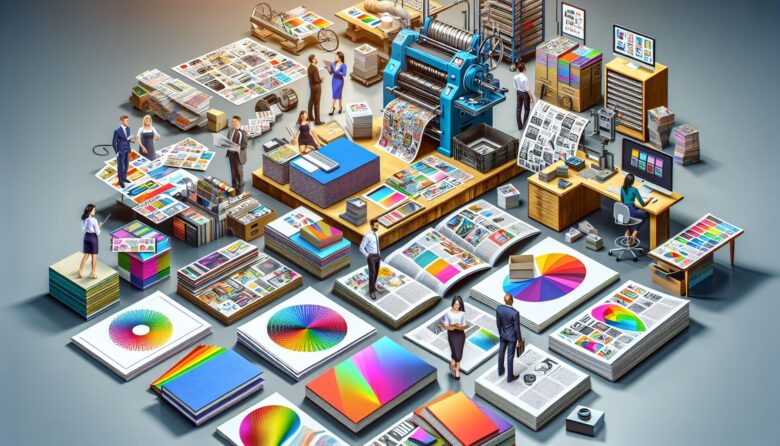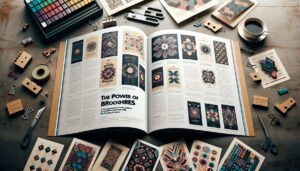Introduction
In today’s digital age, where online content has become the norm, print media still holds a significant place. Among the myriad of printing products available, brochures remain a versatile and effective tool for businesses and organizations to convey their message. A well-designed and carefully printed brochure has the power to captivate readers, provide essential information, and leave a lasting impression. This comprehensive guide explores the world of brochure printing, highlighting its importance, the design process, printing techniques, and marketing strategies.
The Power of Brochures
- Brochures as a Marketing Strategy
Brochures act as powerful marketing tools that can convey a brand message effectively. Whether promoting a product, service, or event, a well-designed brochure grabs attention, informs, and persuades potential customers. Its portability allows businesses to easily distribute brochures at trade shows, exhibitions, and other events, enhancing brand visibility and driving conversions.
- The Versatility of Brochure Design
One of the key advantages of brochures lies in their versatility. They can be used for a wide range of purposes, such as product catalogs, event programs, information guides, and more. With various fold options, sizes, and finishes, brochures allow designers to create captivating layouts that suit the specific needs and objectives of the business or organization.
- Tangible and Memorable
Unlike fleeting digital advertisements, brochures provide a tangible and lasting impression. With visually appealing designs, high-quality paper, and professional printing techniques, brochures engage the reader’s senses and create a deeper connection with the brand or organization. They can be held, flipped through, and stored for future reference, ensuring a longer-lasting impact.
The Brochure Design Process
The key to an effective brochure lies in its design. The following are essential steps in the brochure design process:
- Define the Objective and Target Audience
Before diving into the design process, it is crucial to establish the primary objective of the brochure. Are you aiming to promote a product, educate readers, or provide an overview of your services? Additionally, understanding the target audience is essential in creating a design that resonates with their interests and preferences.
- Content Organization and Hierarchy
Once the objective is defined, the content for the brochure needs to be organized in a logical and visually appealing manner. Create a hierarchy by dividing the content into sections, with attention to headings, subheadings, and bullet points. This organization helps readers navigate the brochure easily and find the information they seek.
- Captivating Visuals and Branding
Visual elements play a vital role in capturing readers’ attention and maintaining their interest. Use high-quality images, illustrations, and graphics that align with the brand identity and represent the intended message effectively. Incorporate the brand’s color scheme, fonts, and logo to maintain consistency and strengthen brand recognition.
- Compelling Copywriting
Engaging and informative copy is the backbone of any brochure. Clearly communicate the key messages, benefits, and unique selling propositions of the product or service. Craft persuasive headlines and taglines that grab the reader’s attention and encourage them to read further. Use concise and impactful language, avoiding jargon or unnecessary fluff.
- Effective Call to Action (CTA)
Every brochure should have a clear call to action that directs readers towards the desired action. Whether it is visiting a website, making a purchase, or contacting the business, the CTA should be prominent, concise, and persuasive. Use actionable language and provide necessary contact details to facilitate a response.
Printing Techniques for Brochures
Printing techniques greatly impact the quality and final appearance of brochures. Here are some popular printing techniques used in brochure production:
- Offset Printing
Offset printing remains the most widely used technique for brochure printing due to its high quality and cost-effectiveness for large print runs. This method involves transferring the inked image from a plate to a rubber blanket, which is then applied to the paper. Offset printing delivers vibrant colors, sharp images, and excellent overall print quality.
- Digital Printing
Digital printing has gained popularity in recent years, particularly for short-run brochure printing. This technique offers quick turnaround times and cost advantages for small quantities. While not matching the exact quality of offset printing, digital printing provides satisfactory results for most brochure designs.
- Specialty Finishes
Specialty finishes can elevate the appearance of brochures, making them even more visually appealing. Options such as embossing, foil stamping, spot UV coating, and die-cut shapes add tactile and visual interest to specific elements of the brochure. These finishes enhance the overall design, create a luxurious feel, and leave a lasting impression on the recipient.
Brochure Marketing Strategies
Designing and printing brochures is only part of the equation. Effective marketing strategies should accompany the distribution process to ensure maximum reach and impact. Here are some strategies to consider:
- Targeted Distribution
Rather than distributing brochures aimlessly, identify the target audience and the specific locations or events where they are likely to be found. Tailor the distribution to reach those who are most likely to have an interest in the product, service, or event being promoted.
- Partnerships and Collaborations
Collaborating with complementary businesses or organizations can be an effective way to expand reach and tap into new markets. Consider partnerships where both parties can benefit from sharing brochures with each other’s customers.
- Inclusion in Mailings
If your business regularly sends out mailings or packages to customers or prospects, consider including a brochure alongside other materials. This ensures that valuable information reaches individuals who have already shown interest in your products or services.
- Brochure Displays
Establish relationships with local businesses that are willing to display your brochures in their establishments. Strategic placement in waiting rooms, lobbies, and community bulletin boards can increase visibility and generate leads.
- Online Integration
While brochures are primarily a print medium, incorporating online elements can amplify their impact. Include a QR code or a web address that leads readers to additional digital content, such as videos, testimonials, or interactive features.
Conclusion
Brochure printing remains a valuable marketing tool that combines tangible impact with creative design. With careful planning, engaging content, and high-quality printing, brochures can effectively convey a brand’s message, inform audiences, and drive conversions. Understanding the design process, printing techniques, and implementing effective marketing strategies allows businesses and organizations to maximize the potential of brochures in reaching and engaging their target audience. Embrace the versatility of brochures and explore the endless possibilities they hold in creating successful marketing campaigns.



